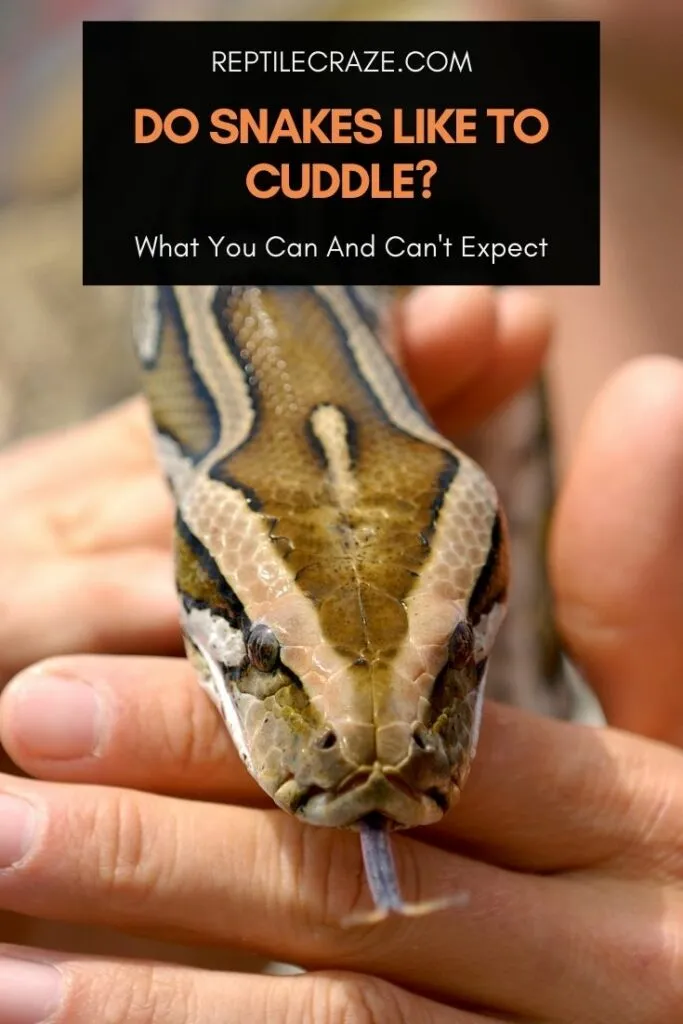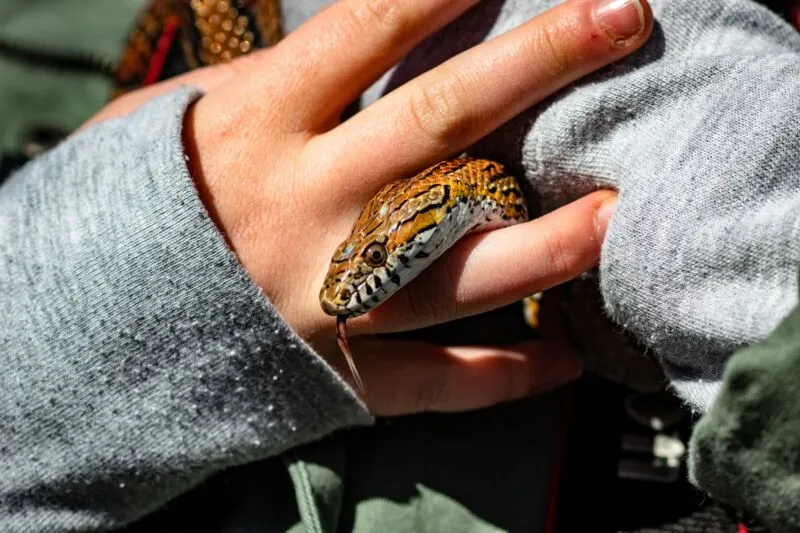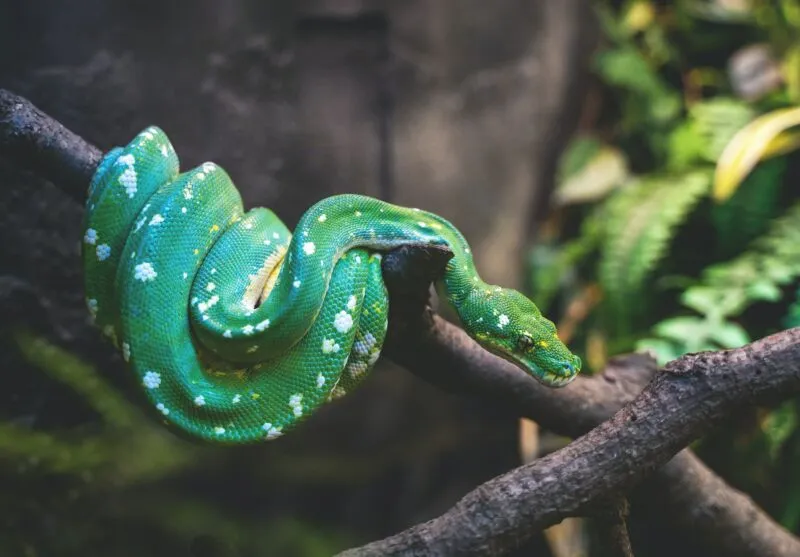
When I got my first snake as a kid, I wondered if my new snake buddy would enjoy a cuddle. I thought it might like physical affection the way a dog or cat does. Most new snake owners often find themselves wondering the same thing.
Snakes do not tend to enjoy cuddling because they have evolved to be solitary creatures. It’s unlikely that snakes respond to physical contact the way mammals and birds do. However, over time a snake can associate you as a positive part of its life due to providing
Some snake species are more likely to allow physical contact. Individuals can also be habituated to affection. Let’s take a look then at what you need to know to enjoy safe physical contact with your snake.
Why Snakes Don’t Cuddle
Snakes don’t cuddle because they don’t have arms… Okay, bad joke, but there are very real physiological reasons as to why cuddling isn’t something snakes do or enjoy.
Solitary Evolution
Most of us enjoy a cuddle with a loved one at some point (don’t worry if that’s not your thing, you do you!). In fact, this sort of physical affection is important for social bonding.
Essentially, we’ve evolved to be in groups. Cuddling is one way we create and maintain deeper relationships in our lives and solidify those groups.
Snakes don’t do this.
Outside of mating, snakes don’t seek each other out (yes, garter snakes are an exception). In fact, most snakes are capable of cannabilism. Some of them seem to outright enjoy it!
The same pull you and I feel to be around other people and have physical contact (when appropriate), your snake feels about solitude. It likes being alone and more than likely doesn’t feel positive emotions during physical contact.
Predator Evasion
While most snakes are expert predators, they are often not at the very top of the
Even in the case of apex snakes like pythons and anacondas, they still have to avoid other deadly competitors within their own species, and animals they share the top of the
Snakes have developed a number of instinctive reactions to animals they are not going to eat. This can be broken down into:
- Fight: A snake will immediately go on the offensive, becoming aggressive and even attacking the other animal.
- Flight: The snake will try to slither away from the other animal as quickly as possible.
- Freeze: The snake will either hide or will play dead, hoping that the animal will move on without eating it.
Don’t feel bad if you struggle to reverse these reactions. After all, your snake’s species invested millions of years to develop them.
Thankfully, neural plasticity in your snake’s brain means he/she can learn new things, even to accept physical touch.

Environmental Hazards
Due to their propensity for isolation, snakes love to hide. In fact, they enjoy nothing more than curling up somewhere safe after a good meal.
Due to their slow metabolism, snakes take upwards of 5 days to digest their
Hiding while digesting is something snakes love. This means being in burrows, under rocks, in trees, and in a hundred and one different difficult environments.
Despite their incredible dexterity, snakes do get trapped from time to time. In these circumstances, snakes use strategies such as rolling and coiling to break free.
This isn’t learned behavior, it’s instinct. Just think how you would feel being stuck inside a tree! Wouldn’t you instinctively move around trying to escape?
This inbuilt reaction bolsters snakes’ already strong aversion to being held. If they think you’re going to trap them, they’ll slide off or roll away as quickly as they can.
Sorry to say, but to your pet snake, you might just be an environmental hazard.
Why Snakes Do Seek Out Physical Contact
While snakes don’t like to cuddle, they will seek out physical contact for a variety of reasons. This usually involves being gently held in the hands of their owners, or sometimes climbing up onto them.
It isn’t out of love, however. It’s always tied to their survival instincts.
Reasons they might want you to hold them, include:
Climbing:
If your snake is a species such as the Amazon Tree Boa, then it’s going to want to climb because it’s an arboreal snake. This is how it moves, hunts, eats, and rests.
And to your pet snake, you might look like a pretty comfortable tree. Hanging from their owners’ arms is something they can take to more easily than ground-dwelling snakes.
Heat:
Snakes are ectothermic. This means that they need heat from their environment in order to regulate their body temperatures. Snakes can be attracted to their owners as a source of heat.
They can also be curious about their owners because they produce heat like prey does. Some snakes will allow close contact if they need, or have been habituated to, getting heat from their owners.
Food:
Yup, your snake gets hungry. If it has become conditioned to associate your presence with that of
Aversion Therapy:
While the instincts of fight, flight, and freeze are powerful, they can be temporarily avoided through something similar to aversion therapy. In aversion therapy, people are put into close proximity with their fears.
After a time of discomfort, they no longer respond with fear because their brains learn that the subject of fear is not a threat. This can happen with snakes as well. With continued handling, a snake will learn to abandon its fear of you.

Best Snake Species for Cuddling (More Like Handling)
While your snake might not want to cuddle, some are more likely to allow handling than others. Many of the snakes most likely to allow handling are also perfect for beginners. Do check the size of each adult, as some of these will need large enclosures!
If you’re looking to have a snake that can be handled regularly, consider buying one of the following:
- Garter Snake
- Corn Snake
- Ball Python
- Rosy Boas
- California King Snake
- Ringneck Snake
Even with snakes that are great for handling, you’ll still want to avoid common snake-handling mistakes.
Snakes to Avoid Handling
It’s not that the following snakes can’t be handled. But you need to be an experienced snake owner to be able to do it properly and safely. If you’re unsure, follow the two golden rules of inexperienced handling:
- If it’s venemous, don’t touch.
- If it’s big and kills its pray with constriction, don’t let it climb on you.
Snakes that should only be handled in the presence of an experienced snake owner, include:
- Boa Constrictors
- Water Snakes
- Green Snakes
- Anacondas
- Burmese Pythons
- Reticulated Pythons
- Wild-Caught Snakes
Conclusion
While your snake is unlikely to enjoy a cuddle, some can be conditioned into being handled correctly. You just need to be able to tell when your snake is happy and understand the behaviors most common in your chosen snake species.
I’d love to hear about your experiences with snake handling. Have any good stories or tips? Please do comment down below.
- Enchi Ball Python: A Unique and Stunning Morph of Python regius - March 27, 2025
- Emerald Tree Monitor: The Enigmatic Green Guardian of the Rainforest - March 26, 2025
- The Egyptian Cobra (Naja haje): A Fascinating Serpent - March 25, 2025
